Existing User Log In
New User Registration
Register for a free account to gain full access to the VGChartz Network and join our thriving community.



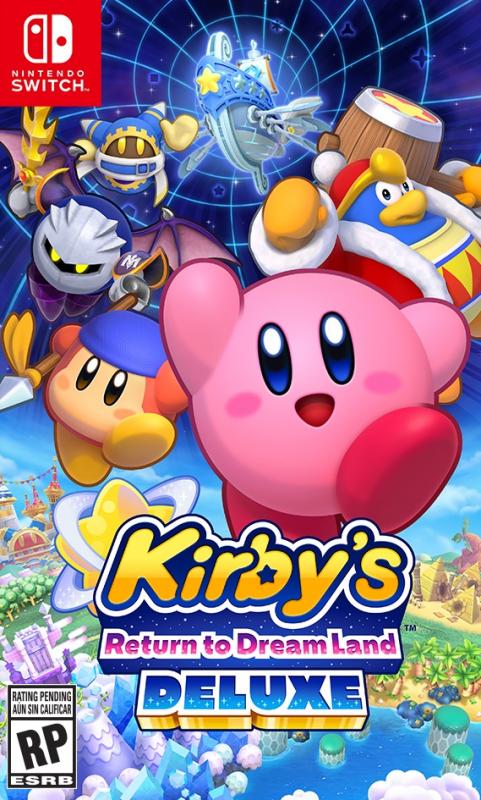

America - Front
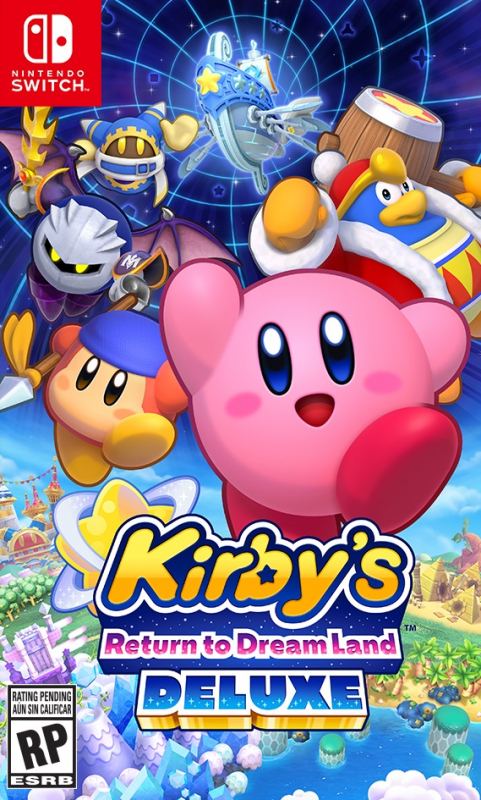

America - Back

The development of Kirby’s Return to Dream Land can be considered anything but smooth. Despite releasing in 2011, Nintendo actually began developing a traditional Kirby home console experience soon after the release of Kirby 64: The Crystal Shards in 2000. However, issues during the game's development influenced several reboots. Originally, this Kirby experience was announced for the GameCube and would emphasize four-player multiplayer, with allies that can help you during your Kirby adventure. Difficulties with development, coupled with the lack of success of the GameCube, influenced a radical change of direction, however.
With the multiplayer idea being stored away, development began on a completely new 3D Kirby experience. What Hal Laboratories didn’t consider was Kirby’s shape. The spherical nature of Kirby caused those testing the game to have difficulties understanding which direction he was facing. Unable to overcome this barrier, the idea of a 3D Kirby experience was also stored away in the Nintendo vault for safe-keeping. Direction quickly shifted back to a rather traditional 2D Kirby experience, and what we received was Kirby’s Return to Dream Land for the Wii in 2011. Solutions to past struggles continued percolating, creating the opportunity to use these ideas in other Kirby projects. Kirby Star Allies released for the Nintendo Switch in 2018 and incorporated that same multiplayer component. In 2022 the first full fat 3D Kirby experience was released, Kirby and the Forgotten Land, again for the Switch.
With this understanding, the remastering of Kirby Return to Dream Land for Switch makes perfect sense. It completes the oeuvre, documenting the title’s development woes represented in each game. Simultaneously, this provides Nintendo the excuse to revamp Return to Dream Land with new graphics, improved performance, and new content. Yet, one might wonder exactly how much has Hal Laboratories done to enhance the experience and, especially, does the gameplay actually hold up in the modern era?
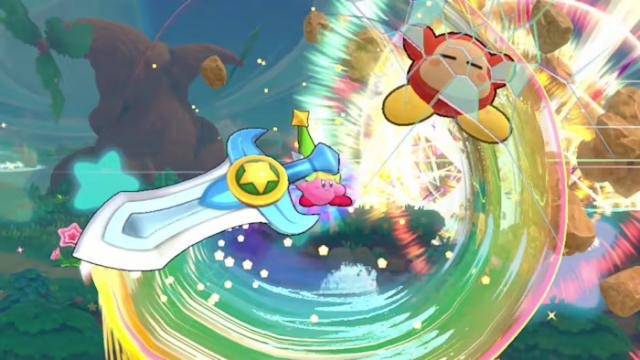
Gameplay-wise, the game shares much more in common with Kirby Star Allies than Kirby and the Forgotten Land. Yes, that means you’ll be getting the traditional Kirby side-scrolling action in a 2.5D format. Levels are generally linear affairs; aside from finding a secret room or area for extra stars, lives, items, or energy spheres, there's only one path to the end goal. The goal is to simply make your way to the end of each level and beat the occasional boss. Kirby does have a health bar that takes repeated hits before he loses a life, and extra lives can be obtained by either finding 1-ups strewn within levels or by collecting 100 stars. He can also fill his health bar up by eating various foods that he finds on the ground (please kids, don’t try this at home).
To make his way to each end goal, Kirby uses a variety of both innate abilities and copy abilities. In his neutral state, Kirby can jump, float, dodge, slide, inhale, and exhale enemies, but this isn’t really the “fun” of Kirby. Instead, the copy mechanic is where the true joy lies. Kirby can inhale enemies, copy their abilities, and assume their attributes. The cutter ability gives you a boomerang that can lop off various ropes and vines, causing hazards for enemies and opening up secrets. The fire ability allows you to blow fire at enemies or even turn into a fireball that accelerates at breakneck speed.
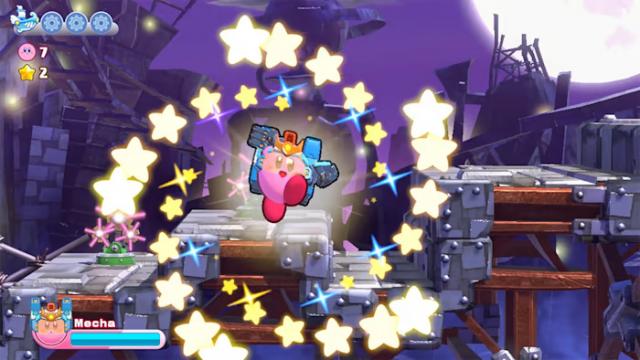
Each ability has a set of attributes and uses which can be utilized to solve puzzles or access secret areas. For example, the water ability can be used to cool off fire blocks, allowing them to be broken. I appreciate the amount of moves most of these abilities have. As if to emulate fighting titles like Super Smash Bros., you can execute a variety of attacks with relatively simple control inputs, which feels satisfying. The game also features super abilities, which are suped-up versions of a handful of abilities given to you on specific stages, causing damage to enemies across the entire screen. Although these are used rather sparingly, when they are used, it makes you feel suitably powerful.
When playing through the main campaign, most abilities’ moves aren’t utilized to terrific effect. In fact, the main campaign has such little challenge - even on hard mode - that I'm quite certain I would be able to beat the game without the use of a single copy ability if I wanted to. However, the abilities and move list really shine in the various challenges that you can unlock. These timed challenges require that you know an ability front and back, and understand which moves are the most well-equipped to handle specific enemy placements and obstacles for the maximum amount of points, with little room for error. To unlock these challenges, you’ll have to collect energy spheres. Around three to five can be found depending on the level, a bit like the Star Coins in the New Super Mario Bros. games. These spheres also unlock ability rooms and mini-games, in addition to the aforementioned ability challenges, when taken to the hub area.
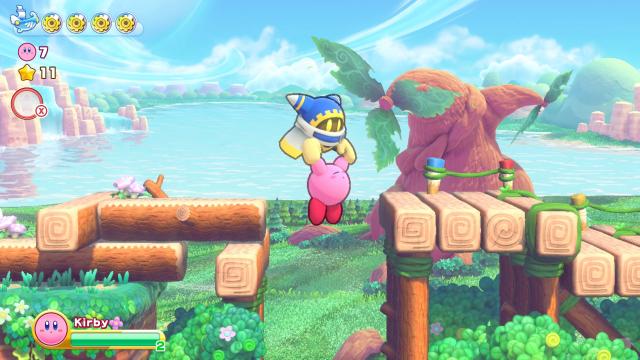
Collecting the spheres has been made slightly easier in this entry. Instead of forcing you to have a sort of precognition, anticipating the exact ability you may need to solve the puzzle in a secret room, the ability will be located very close to the room you may need it in. I found this change to be very welcome, as it prevented frustrating circumstances where the ability I needed was lost or simply forgotten, causing me to repeat the level. Bosses also appear to have far more HP than in the original release, increasing the overall difficulty level.
As stated before, though, the main game really isn't very tough. Without trying, I had amassed several dozen extra lives for Kirby before I’d ever died once. Of course, after you complete the game with a specific amount of energy spheres, you'll unlock Extra Mode, a much more difficult mode with more aggressive enemies, harder bosses, less health, and little in the way of restorative items. There are two different boss endurance modes: The Arena and True Arena. These modes are definitely more challenging than the main game and also include added bosses from the Wii version.
Despite the inclusion of these other modes, I’m still a bit frustrated at the requirement of beating the game to get access to any actual challenge. Return to Dream Land Deluxe is just so painfully easy that I really feel more should be offered regarding difficulty options for veteran players. To add insult to injury, Hal Laboratories actually went back and added an extra difficulty mode that wasn’t available on the Wii, which makes the game even easier. If the developers had the opportunity to make the game easier, surely they also had the ability to add a harder difficulty too, particularly for those who may have played the original 2011 release, right?
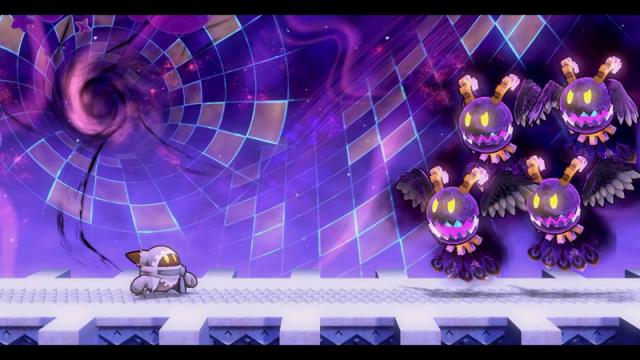
There are some added gameplay changes from the original release on Wii. There are three added abilities: sandstorm, mecha, and festival (although that last ability is just a one-time use and isn't particularly interesting). Some abilities are easier to control too, having been updated to resemble newer entries in the series, or given added attributes (e.g. the tornado ability can now cool off fire blocks as well). Kirby’s swimming has been overhauled to feel much more fluid (no pun intended), and now allows for diagonal attacks with his water gun. These changes are all very welcome, and help solidify Kirby’s Return to Dream Land Deluxe as the definitive experience, even without considering the extra content or graphical overhaul.
Talking of graphical overhaul, everything has been completely remade using the original’s art style as a base, while also considering the changes that have been incorporated into the series since then. There are very dark outlines that now surround player characters, which feel directly influenced by Super Smash Bros. 3DS. Subjectively, I like the added outlines, but I do think that the models could have held up without them, and adding a toggle would have been appreciated for those who dislike the outlines. The game is now 60FPS too, and everywhere but Merry Magoland is rock solid. I didn’t once notice any dropped frames or stuttering during my time with the game.
Return to Dream Land Deluxe is also crystal clear. Though I didn’t sit there counting pixels, it's pretty apparent to me that it’s a native 720p on the Switch’s portable screen and 1080p docked or, at least, as close to those resolutions as possible. My time was mostly spent playing portably on my OLED. The combination of native resolution, smooth gameplay, and Kirby’s signature vibrancy really shined on the OLED. At a time when the Switch is showing its age, Hal Laboratories shows us how Switch games can continue to look good by emphasizing quality art design with modest technical targets.
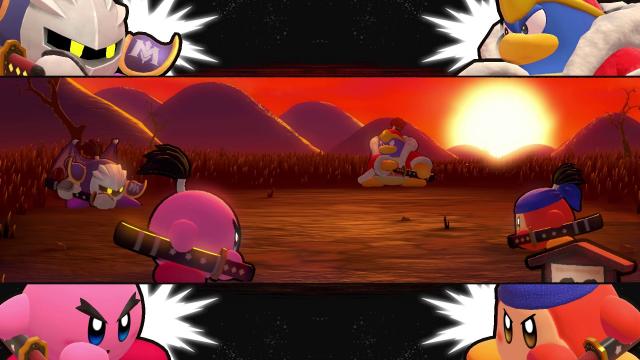
Character models are often a 1:1 faithful recreation, just with added polygons and improved textures, but you'll also find some larger changes in characters like King Dedede, who is now closer to his design from Kirby and the Forgotten Land. Stages are occasionally given the extra added backdrop to make the world feel more connected, but are generally extremely faithful recreations of what was found on Wii. The majority of animations are very similar, though there are some added animations or recreated animations, which provide a subtle improvement over the original release. The theme surrounding the graphical changes truly makes this feel like a “remaster-plus”. Yes, the game has received a complete graphical remake, but it stays so close to the original design that it still feels like a remastered experience.
To break away from the side-scroller action is the added Merry Magoland. This provides a collection of mini-games, though these mini-games can also be found in the hub area of the main game. There are challenges that can be completed for each one, which reward you with stamps to unlock various masks that can be worn during Kirby’s adventure. These masks don’t have any effect on the gameplay, but they provide a small incentive to challenge yourself in the mini-games. There's also a tour mode, which provides a setlist of randomized mini-games too, allowing you to challenge CPU opponents or even friends to find out who can take number one. A subtle addition, but an appreciated one that gives you some fun with friends. This is also where you can buy “souvenirs”, which are items like maxim tomatoes or randomized copy abilities that can be used throughout the game. I never felt it necessary to use these, but they would give those who are struggling to defeat a boss extra help.
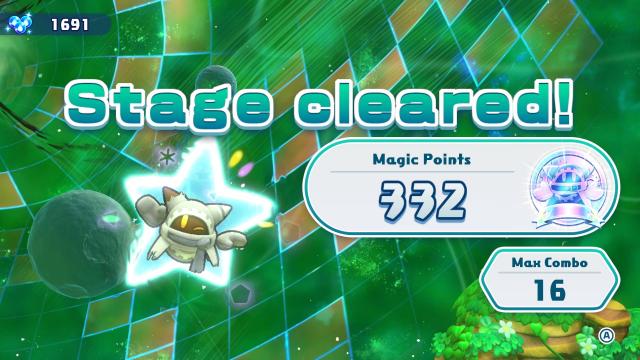
Finally, there's an entirely new epilogue featuring Magalor as the protagonist, taking place immediately after the end of the main game. This added mode is surprisingly robust and addicting. Magalor cannot copy abilities, as Kirby can. In its place is an RPG-esque move system; Magalor has several basic moves which can be upgraded with magic points. Magic points are obtained by defeating enemies, but setting up combos can increase the amount of magic points that are given. These magic points are also used for assessing the “completion” of a level, offering silver, gold, or platinum medals depending on how many points you received. I found myself repeating levels over and over again to string together combos for more points in order to obtain the coveted platinum medal completion.
There are four areas here, with each area ending in a boss battle. Bosses are based upon enemies already within the main game, but they feature some alterations and added abilities or stage events. Even though bosses hold similarities, the difference in Magalor’s moveset and the mode's emphasis on combos makes them feel incredibly fresh and fun. After defeating one, you'll unlock a new ability, which of course can be upgraded along the way. In some ways, the introduction of the combo mechanic actually made this mode more interesting for me than the main game, and I hope this can be incorporated to an extent into a mainline Kirby title to provide players with a little extra replayability.
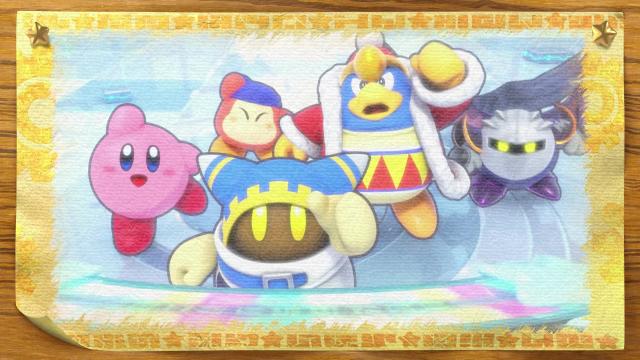
Kirby Return to Dream Land Deluxe offers the definitive experience of a good Kirby game. Compared to other Deluxe editions that Nintendo has released on the Switch (e.g. Pikmin 3 Deluxe), this is one of the best. When compared to more recent remakes of games from this era though (e.g. Dead Space), it doesn’t quite hit the mark. Graphically, it’s a completely remade experience using the original as a base, and it does hold up well against other tailor made titles for the Switch. The added content and subtle gameplay adjustments are also appreciated and help make the experience & presentation feel of consistent quality. Still, it's not much different from what you may have already played on the Wii, so I'd really only recommend it to die hard Kirby fans and those who have played very little or none of the original Wii release. More casual Kirby players that own or have beaten the original game on the Wii may not find enough here to justify the purchase.